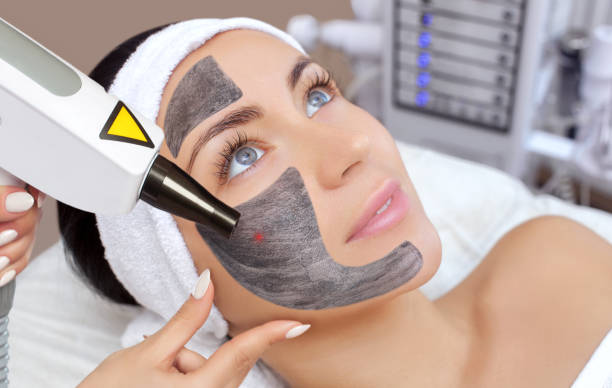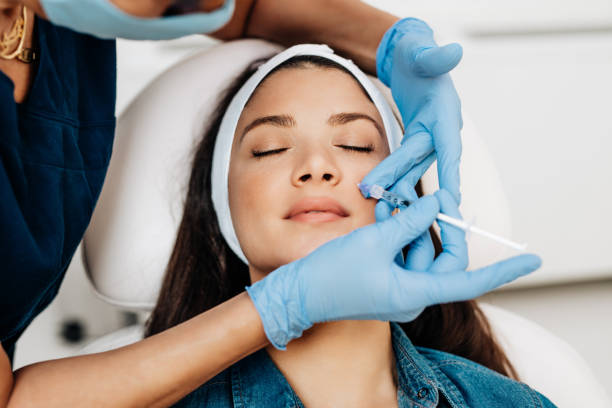
Laser skin resurfacing is a popular cosmetic procedure that can help improve skin texture, reduce fine lines and wrinkles, and fade scars and blemishes. However, it is important to be aware of the long-term effects of this treatment before deciding to undergo it. Some of the potential long-term effects of laser skin resurfacing can include changes in skin pigmentation, scarring, and increased sensitivity to sunlight. It is important to discuss these risks with your dermatologist or cosmetic surgeon before undergoing the treatment.
Additionally, the cost of laser skin resurfacing can vary based on several factors, including the area being treated, the type of laser used, and the experience of the provider. On average, the cost of laser skin resurfacing can range from $1,000 to $3,000 per treatment. Despite the potential risks and costs associated with laser skin resurfacing, it can be an effective way to improve the appearance of your skin when performed by a qualified professional with experience in this area.
Pro Tip: Always do your research and choose a reputable provider with good reviews and credentials. Don’t be lured by cheaper prices as lower costs can indicate inferior treatments.
What is Laser Skin Resurfacing?
Laser skin resurfacing is a cosmetic procedure that uses focused beams of light to improve the look and feel of your skin. It can treat wrinkles, scars, and discoloration, giving you a healthier and smoother complexion. But what are the long-term effects of this procedure? In this article, we’ll dive into the details to explore the potential benefits and risks of laser skin resurfacing.
How Does Laser Skin Resurfacing Work?
Laser Skin Resurfacing is a cosmetic treatment that involves the use of a laser to reduce facial wrinkles, scars, blemishes, and other skin irregularities. The laser works by removing the outermost layer of the skin, which stimulates the natural healing process and promotes the growth of new skin cells. The long-term effects of laser skin resurfacing can be quite significant, including improved skin texture, reduced hyperpigmentation, and increased collagen production.
The cost of laser skin resurfacing depends on various factors such as the type of laser used, the size of the area being treated, and the location of the clinic. On average, the cost can range from $1,000 to $3,000 per treatment session. It is important to note, however, that laser skin resurfacing is usually considered a cosmetic procedure and is not covered by health insurance. It is best to consult with a dermatologist to determine if laser skin resurfacing is right for you and to determine the exact cost based on your specific needs.
What Are the Different Types of Laser Skin Resurfacing?
Laser skin resurfacing is a popular cosmetic treatment that uses targeted laser technology to improve the appearance of fine lines, wrinkles, and skin imperfections.
There are three main types of laser skin resurfacing treatments:
- Ablative Laser Resurfacing: This is the most intensive type of laser resurfacing, which removes the top layer of the skin, triggering the growth of new skin cells. This procedure is often used to treat severe aging signs and requires significant downtime.
- Non-ablative Laser Resurfacing: This type of laser resurfacing does not remove any layers of skin. Instead, it encourages collagen production to improve skin texture and minimize the appearance of fine lines and wrinkles.
- Fractional Laser Resurfacing: This type of resurfacing targets only a portion of the skin, leaving tiny areas of untouched skin to speed up the healing process. It is a less invasive procedure, and recovery time is shorter than ablative resurfacing.
While laser skin resurfacing can be costly, depending on the extent of treatment required, the benefits can be long-lasting, making it a worthwhile investment for many patients. Additionally, lasting results can effectively curb costs tied to over-the-counter or short-term solutions.
How Is Laser Skin Resurfacing Different From Other Skin Resurfacing Treatments?
Laser Skin Resurfacing is a popular cosmetic procedure that can address a range of skincare concerns such as acne scars, fine lines, wrinkles, and hyperpigmentation. It is significantly different from other skin resurfacing treatments in many ways. Unlike microdermabrasion or chemical peels, which employ abrasive substances or chemical agents to remove the outermost layer of the skin, Laser Skin Resurfacing uses a high-intensity laser beam to create controlled wounds in the skin tissue, stimulating the production of collagen and new skin cells.
Laser Skin Resurfacing often requires only one treatment, whereas other treatments may require several sessions. While the cost of Laser Skin Resurfacing can vary depending on the provider, the treatment area, and the extent of the procedure, it is a long-term investment in the appearance of your skin, with results lasting up to 10 years.
Pro Tip: Consult a board-certified dermatologist to determine if Laser Skin Resurfacing is right for you.
Short-Term Effects of Laser Skin Resurfacing
Laser skin resurfacing is a popular non-surgical cosmetic procedure that can improve skin texture and tone. It can reduce wrinkles, blemishes, and even out skin pigmentation. Immediate results are often visible right after the procedure but what are the short-term effects of laser skin resurfacing? In this article, we will discuss the benefits and potential side effects of laser skin resurfacing, so you can make an informed decision when considering the procedure.
What Are the Immediate Effects of the Treatment?
Laser skin resurfacing is a cosmetic treatment that uses an intense light beam to remove damaged skin cells and stimulate collagen production. The immediate effects of the treatment include redness, swelling, and a burning sensation, which can last for up to a week. Your skin will also be more sensitive to the sun, and you may experience temporary hyperpigmentation or hypopigmentation.
Long-term effects of laser skin resurfacing include smoother and firmer skin, reduction in fine lines and wrinkles, and improved skin texture and tone. The results of the treatment can last for several years, but this depends on factors such as your skin type, sun exposure, and lifestyle habits. Laser skin resurfacing costs vary depending on the extent of the treatment and the region you live in, but it typically ranges from $1,000 to $5,000 per session. Pro tip – To ensure the best results, choose a board-certified dermatologist with experience in laser skin resurfacing.

How Long Does Recovery Take?
The recovery time for laser skin resurfacing depends on several factors, such as the specific type of treatment, the extent of the procedure, and the individual’s skin type. Typically, the recovery period can range from a few days to several weeks.
Short-term effects of laser skin resurfacing include redness, swelling, and mild pain or discomfort. These side effects usually subside within a week or two after the treatment, and the patient can resume their regular activities. However, it is essential to avoid direct sun exposure during this time and to follow the aftercare instructions provided by the doctor.
Long-term effects of laser skin resurfacing result in smoother, more youthful-looking skin, and improved texture and tone. Depending on the individual’s skin concerns, multiple treatments may be necessary to achieve the desired results. The cost of laser skin resurfacing varies depending on the type of treatment and the location, with prices ranging from a few hundred to several thousand dollars.
Pro tip: Consult with a dermatologist to determine the best laser skin resurfacing treatment plan and to ensure a successful recovery.
When Can I Expect To See Results?
The results of laser skin resurfacing can vary depending on the individual’s skin type, the intensity of the treatment, and the number of sessions undergone.
Short-term effects can be seen within the first week after treatment, including redness, slight swelling, and peeling of the skin. These effects typically subside within a few days to a week. Long-term effects can take longer to become visible, with improvements in skin texture, tone, and the appearance of fine lines and wrinkles becoming noticeable within a few months after treatment.
It is important to note that laser skin resurfacing is a gradual process, and multiple sessions may be required to achieve optimal results. The cost of laser skin resurfacing varies depending on the extent of the procedure, but typically ranges from $1,000 to $3,000 per session. It is always recommended to seek advice from a certified dermatologist before undergoing any laser skin resurfacing treatment. They can guide you on how much laser skin is resurfacing and whether it is suitable for your skin type and needs.
Long-Term Effects of Laser Skin Resurfacing
Laser Skin Resurfacing is a medical procedure that is becoming increasingly popular as a way to remove wrinkles, blemishes, and other skin imperfections. It works by using laser energy to remove the outermost layer of skin, revealing a smoother and more even complexion. With this procedure, however, it is important to know what the long-term effects may be. This section will discuss the potential long-term effects of laser skin resurfacing, including potential risks and benefits.
How Much Time Does It Take for Long-Term Effects to Show Up?
Laser skin resurfacing is a cosmetic procedure that involves the use of lasers to improve the appearance of the skin. While this procedure can yield immediate results, it may take several months to see the full extent of the long-term effects.
The duration of time that it takes for long-term effects to show up after laser skin resurfacing varies from patient to patient depending on multiple factors such as the depth and intensity of the treatment, the patient’s age and overall health, and the post-treatment aftercare. Some patients may see optimal results within a few weeks, while others may experience gradual improvement over several months.
It is important to follow your doctor’s aftercare instructions carefully to minimize the risk of complications and ensure the best possible outcome. These instructions may include avoiding sun exposure, using sunscreen, and regularly moisturizing your skin. With proper care, the long-term effects of laser skin resurfacing can last up to several years, making it a popular cosmetic procedure.
What Are the Common Long-Term Effects of Laser Skin Resurfacing?
Laser skin resurfacing is an effective cosmetic procedure for reducing the signs of aging and improving the appearance of the skin. However, it’s essential to be aware of the long-term effects of this procedure before undergoing it.
Here are some common long-term effects of Laser Skin Resurfacing:
- Increased sensitivity to sunlight: Your skin may become more sensitive to sunlight, even after you’ve completely healed from the procedure.
- Dryness: The treated area may become dry and flaky, as the laser can damage the oil-producing glands.
- Discoloration: In rare cases, laser skin resurfacing can cause hyperpigmentation or hypopigmentation in the treated area.
- Scarring: Though uncommon, laser skin resurfacing can sometimes lead to scarring, especially if proper aftercare instructions are not followed.
It’s always best to consult with a dermatologist to understand how much laser skin resurfacing costs and the possible risks involved. Pro tip: Always follow the pre and post-procedure care guide provided by a dermatologist to avoid the long-term effects of laser skin resurfacing.
What Are the Risks and Complications of Laser Skin Resurfacing in the Long Run?
Laser skin resurfacing is a popular cosmetic procedure for achieving clearer, smoother and more youthful-looking skin. However, there are some long-term risks and complications associated with it that should be taken into consideration before undergoing the procedure, especially for individuals with more sensitive skin.
While the potential complications vary depending on the type of laser used and the patient’s skin type, long-term risks may include:
- Hyperpigmentation or hypopigmentation.
- Scarring or infection.
- Delayed healing or swelling.
- Changes in skin texture, especially if the skin is prone to keloids or scarring.
It is important to discuss any concerns or potential risks with a qualified dermatologist or healthcare provider before undergoing the procedure. This will help to determine if the benefits of laser skin resurfacing outweigh the associated risks and whether this is a suitable treatment option for the patient.
How Much Is Laser Skin Resurfacing
Laser skin resurfacing is an innovative cosmetic procedure that can help improve the texture, tone, and appearance of your skin. It can help reduce signs of aging and improve overall skin health. Before diving into this procedure, it’s important to understand how much it is likely to cost and how long it will take to recover. In this article, we will discuss the cost and duration of laser skin resurfacing.

How Much Does Laser Skin Resurfacing Cost?
Laser Skin Resurfacing is a clinical procedure that is designed to enhance the texture, tone, and appearance of the skin. The cost of this treatment depends on various factors such as the type of laser used, the extent of the area to be treated, the experience and expertise of your cosmetic surgeon, and the location of the clinic. The average cost of Laser Skin Resurfacing ranges between $1,000-$5,000 per session. The duration of the treatment depends on the size of the area being treated and can last between 30 minutes to 2 hours.
While the treatment has instant benefits such as smoother and more youthful-looking skin, there are also long-term effects of Laser Skin Resurfacing. These include lasting improvements to skin pigmentation, reduction in the appearance of fine lines and wrinkles, and increased collagen production, among others.
Pro Tip – Before undergoing this treatment, schedule a consultation session with your doctor to discuss the potential risks and benefits of Laser Skin Resurfacing.
What Factors Affect the Cost of Laser Skin Resurfacing?
The cost of laser skin resurfacing is based on several factors. The type of laser used, the depth of the treatment, the geographic location of the provider, and the provider’s experience are all factors that affect the cost of laser skin resurfacing. The cost of laser skin resurfacing can range from $1000 to $5000. However, the cost varies depending on the extent of the treatment area and the objectives of the treatment.
The long-term effects of laser skin resurfacing include a reduction in the appearance of wrinkles, pores, and scars. It also improves skin tone, texture, and overall appearance. The duration of laser skin resurfacing varies from patient to patient and depends on individual factors such as skin type and the intensity of the treatment.
Pro Tip: It’s important to choose a provider who has experience with laser skin resurfacing and is transparent about the cost and any potential risks involved in the procedure.
How Long Does Laser Skin Resurfacing Last?
Laser skin resurfacing is a cosmetic procedure that uses laser technology to improve skin texture, reduce wrinkles, and minimize sun damage. The longevity of its effects depends on various factors, such as the patient’s age, skin condition, and lifestyle habits.
Here are some general guidelines to keep in mind: Immediately after the procedure, you may notice a significant improvement in your skin’s appearance that can last up to two years. However, the long-term effects of laser skin resurfacing can vary. Typically, patients can expect the results to last anywhere from three to five years. To maintain the results, it’s crucial to take good care of your skin, protect it from the sun, and follow a healthy lifestyle with balanced nutrition and regular exercise.
The cost of laser skin resurfacing can range from $1,000 to $3,000 per treatment. However, the cost can vary depending on the type of laser used, the extent of the treatment, and the location of the clinic. It is always better to consult a dermatologist and discuss the treatment’s cost and duration before proceeding with it.
Pro Tip: Make sure to follow the prescribed aftercare routine to optimize the longevity of the effects of laser skin resurfacing.
Pre and Post-Treatment Care
Laser skin resurfacing is a very effective treatment for smoothing out wrinkles, removing age spots, and improving overall skin tone and texture. It is important to understand the pre and post-treatment care that must be taken in order to ensure the best and safest results after the laser treatment. In this article, we’ll discuss the steps needed to prepare for and recover from laser skin resurfacing.
How Should I Prepare for a Laser Skin Resurfacing Procedure?
Before undergoing a laser skin resurfacing procedure, there are a few steps you should take to prepare yourself for the treatment and minimize the potential risks and complications.
Here’s what you need to do before the procedure:
- Consult with a dermatologist or plastic surgeon to discuss the treatment options and determine if laser skin resurfacing is right for you.
- Avoid any medications, supplements or herbal remedies that may increase your risk of bleeding, such as aspirin and vitamin E, in the weeks leading up to the procedure.
- Stop smoking or using nicotine products, as they can interfere with the healing process.
- Arrange for a ride home after the procedure, as you may be groggy or drowsy from the anesthesia.
- Plan for the post-treatment aftercare, such as taking time off from work, avoiding sun exposure and wearing sunscreen.
The cost of laser skin resurfacing can vary depending on the type of treatment, the extent of the procedure, and the location of the clinic. The average cost for a single treatment can range from $1,000 to $3,000, with more extensive treatments or combined treatments costing more. However, it is always best to consult with a professional to determine the exact cost and find out if insurance covers the expenses.
Pro-tip: Follow the post-treatment care instructions provided by your doctor to maximize the results and minimize the risk of complications.
What Should I Do Post-Treatment to Take Care of My Skin?
Post-treatment care is critical to ensure your skin heals properly after undergoing laser skin resurfacing treatment. Here are a few tips for taking care of your skin post-treatment:
- Avoid direct exposure to sunlight for the first few days after the treatment. Wear a wide-brimmed hat when outdoors.
- Keep the treated area moisturized to prevent scabbing and dryness. Use a moisturizer recommended by your dermatologist.
- Use a gentle cleanser to wash your face, and avoid exfoliating the treated area until it has fully healed.
- Do not pick at scabs or blisters as that can lead to scarring.
- Apply a broad-spectrum sunscreen with SPF 30 or higher daily to protect your skin from UV rays.
It’s important to follow your dermatologist’s instructions for post-treatment care to ensure optimal results and prevent any potential long-term effects.
Pro tip: Laser skin resurfacing cost varies depending on several factors like the size of the treated area, the type of laser used, and the location of the dermatologist. It’s essential to consult with an experienced dermatologist to get an accurate cost estimate.
What Are the Possible Side Effects and How to Manage Them?
Laser skin resurfacing is a safe and effective aesthetic treatment that can improve the quality and appearance of the skin. However, as with all medical treatments, there are potential risks and side effects to be aware of. Some common side effects of laser skin resurfacing are redness, swelling, itching, pain, and peeling. These side effects typically subside within a few days or weeks of the treatment, depending on the intensity of the procedure.
To manage the side effects of laser skin resurfacing, it is important to follow the post-treatment care instructions given by your dermatologist or aesthetician. This may include avoiding direct sun exposure, using a gentle cleanser and moisturizer, and applying a cold compress to the treated area. It is also important to avoid picking or scratching at the treated area, as this can lead to scarring and additional skin damage.
Long-term effects of laser skin resurfacing are generally positive, including improved skin quality, tone, and texture. However, it is important to maintain good skincare habits and protect your skin from sun damage to ensure lasting results.
Pro tip: Consult with your dermatologist or aesthetician about the expected side effects and best post-treatment care options for your specific skin type and laser resurfacing treatment. Also, research and compare costs before finalizing the treatment as it is an expensive process, ranging from $1000 to $5000 depending on the area to be treated.










